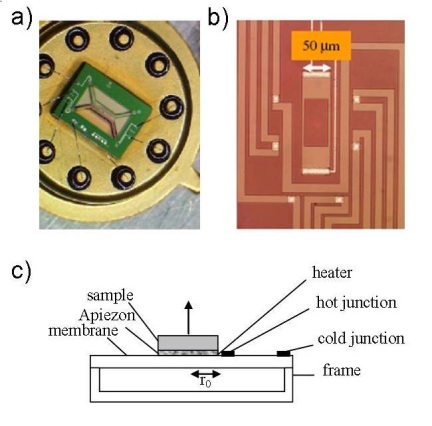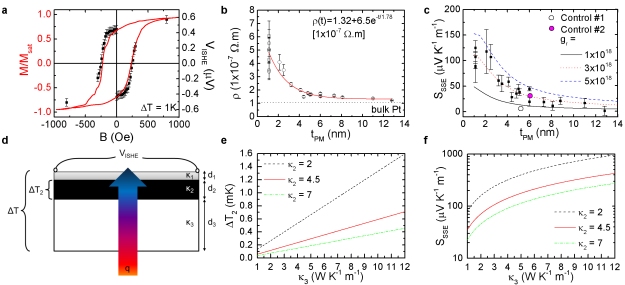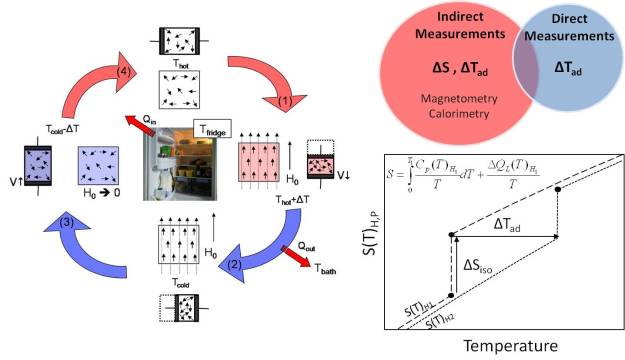- Magnetism – magnetocaloric effect, spin glasses, magnetic domains.
- Thin film deposition and devices, including 2D materials and heterostructures.
- Scanning probe microscopy techniques, including thermal scanning lithography.
- Spin caloritronics – in particular the spin Seebeck effect.
- Phase transitions – universality, latent heat, hysteresis and definition of a first order phase transition.
- Heat capacity measurements – standardisation and limits.
- Neutron scattering – reflectivity, elastic and inelastic scattering as a probe of magnetic structure and excitations.
- Superconductivity.
Selected Publications
Enhancement of spin Seebeck effect in Fe3O4/Pt thin films with α-Fe nanodroplets, Appl. Phys. Lett. 123, 172408 (2023)
Measurement of the heat flux normalised spin Seebeck coefficient of thin films as a function of temperature, Rev. Sci. Instr. 91, 073910 (2020)
Magnon diffusion lengths in bulk and thin film Fe3O4 for spin Seebeck applications, Phys. Rev. Mat. 4, 075402 (2020)
Anomalous Nernst effect in Co2MnSi thin films, J. Phys. D 53 035005 (2019)
Spin Seebeck effect in polycrystalline yttrium iron garnet pellets prepared by the solid-state method, EPL 126 37001 (2019)
Demonstration of polycrystalline thin film coatings on glass for spin Seebeck energy harvesting, Phys. Stat. Sol., RRL 10 613-617 (2016)
Selected Grants
EPSRC Strategic Equipment Grant “Rapid Prototyping of Novel Devices with In-situ Deposition, Imaging and Nanolithography” October 2021-March 2024
EPSRC New Horizons Grant “Seeing magnons at spin-to-charge conversion interfaces”, CI July 2021 – December 2022
EPSRC Early Career Fellowship “Reliable, Scalable and Affordable Thermoelectrics: Spin Seebeck Based Devices for Energy Harvesting” January 2017 – October 2022
EPSRC First Grant “Feasibility of heat conversion to electricity by new spin Seebeck based thermoelectrics” April 2014 – April 2016
Spin Caloritronics: A future breakthrough for thermoelectric devices?
Spin caloritronics describes the field of research that bridges the gap between spintronics and calorimetry. An example of the phenomena observed is the spin Seebeck effect: generation of a spin polarised current due to a temperature gradient. This effect was first measured by way of the inverse spin Hall effect by Uchida et al. (Nature Letters 455, 778 (2008)). One advantage of this field of research is the potentail to break the Wiedemann-Franz law that currently limits the efficiency of thermoelectric devices, thus boosting development of (waste heat) energy harvesters.
The Magnetocaloric Effect: Possibility for Magnetic Refrigeration?
The magnetocaloric effect manifests as a change in temperature of a material on adiabatic application of magnetic field as a result of conservation of entropy. Recent research into this effect has focussed on the potential application for room temperature magnetic refrigeration as a more efficient alternative to the current gas compression technology. Current research challenges include material availability, machinability, thermal control and cycling fatigue.
Heat capacity measurements: Developing a standard approach.
There several fundamentally different methods for measurement of the heat capacity of a material. Perhaps the most widely known is the adiabatic calorimeter deeloped by W. Nernst: perhaps the most accurate technique for determination of the heat capacity, but which requires long timescales and large samples (~ grams). Differential Scanning Calorimetry (DSC), on the other hand, is the more accurate when the determination of the total heat flux across a first order phase transition (where latent heat is present), is required. When comparing data obtained using different apparatus there are several factors that need to be considered including the sample preparation, demagnetisation field, calibration procedure and data analysis routine.
 |

